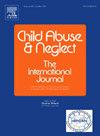童年不良经历与青春期和成年期抑郁症状:一个潜在类别分析和时变效应模型
IF 3.4
2区 心理学
Q1 FAMILY STUDIES
引用次数: 0
摘要
不良童年经历(ace)对抑郁症有很大影响。不同类型的ace与抑郁症状之间的联系可能因年龄和性别而异。目的本研究的目的是确定ace的模式,并检查青春期和成年初期不同类型ace与抑郁症状之间的关系的性别差异。本研究使用的数据(N = 3342)来自全国青少年到成人健康纵向研究。方法首先用潜金法确定最合适的模型。然后,将每个类别(参考类别除外)的二分类指标作为时变预测因子输入模型,以检验类别成员对年龄抑郁症状的影响。结果确定了5类模型:(1)低ace、(2)父母酗酒与离婚、(3)暴力、(4)虐待与忽视、(5)多重ace。在23岁和27.5岁时,多重ace分类与抑郁症状之间的关联在女性中强于男性。在13.5岁至16岁、23岁至30岁的女性参与者中,父母酒精使用和离婚类别与抑郁症状之间的关联比男性参与者更强。在19至23岁的参与者中,处于虐待和忽视类别的女性抑郁症状水平较高,而男性则不然。结论需要进一步探讨早期逆境和性别对抑郁症状发生时间和持续时间的协同效应本文章由计算机程序翻译,如有差异,请以英文原文为准。
Adverse childhood experiences and depressive symptoms across adolescence and adulthood: A latent class analysis and time-varying effect model
Background
Adverse childhood experiences (ACEs) greatly affect depression. The association between different patterns of ACEs and depressive symptoms might differ across age and gender.
Objective
The aim of the study was to identify patterns of ACEs and examine gender differences in the association between different patterns of ACEs and depressive symptoms across adolescence and emerging adulthood.
Participants and setting
The study used data (N = 3342) from the National Longitudinal Study of Adolescent to Adult Health.
Methods
We first used Latent Gold to identify the most suitable model. Then, dichotomous indicators of membership in each class (except for a reference class) were entered in the model as time-varying predictors to test the effect of class membership on depressive symptoms over age.
Results
A 5-class model was identified: (1) Low ACEs, (2) Parental Alcohol Use and Divorce, (3) Violence, (4) Abuse and Neglect, and (5) Multiple ACEs. The association between Multiple ACEs classification and depressive symptoms was stronger for women than men at ages 23 and 27.5. The association between being in the Parental Alcohol Use and Divorce class and depressive symptoms was stronger for female participants than male participants between ages 13.5 and 16, and ages 23 and 30. Being in the Abuse and Neglect class was significantly associated with higher level of depressive symptoms for female, but not male, participants between ages 19 and 23.
Conclusion
Findings point to the need for further inquiries into the synergistic effects of early adversity and gender on the timing and persistence of depressive symptoms
求助全文
通过发布文献求助,成功后即可免费获取论文全文。
去求助
来源期刊

Child Abuse & Neglect
Multiple-
CiteScore
7.40
自引率
10.40%
发文量
397
期刊介绍:
Official Publication of the International Society for Prevention of Child Abuse and Neglect. Child Abuse & Neglect The International Journal, provides an international, multidisciplinary forum on all aspects of child abuse and neglect, with special emphasis on prevention and treatment; the scope extends further to all those aspects of life which either favor or hinder child development. While contributions will primarily be from the fields of psychology, psychiatry, social work, medicine, nursing, law enforcement, legislature, education, and anthropology, the Journal encourages the concerned lay individual and child-oriented advocate organizations to contribute.
 求助内容:
求助内容: 应助结果提醒方式:
应助结果提醒方式:


